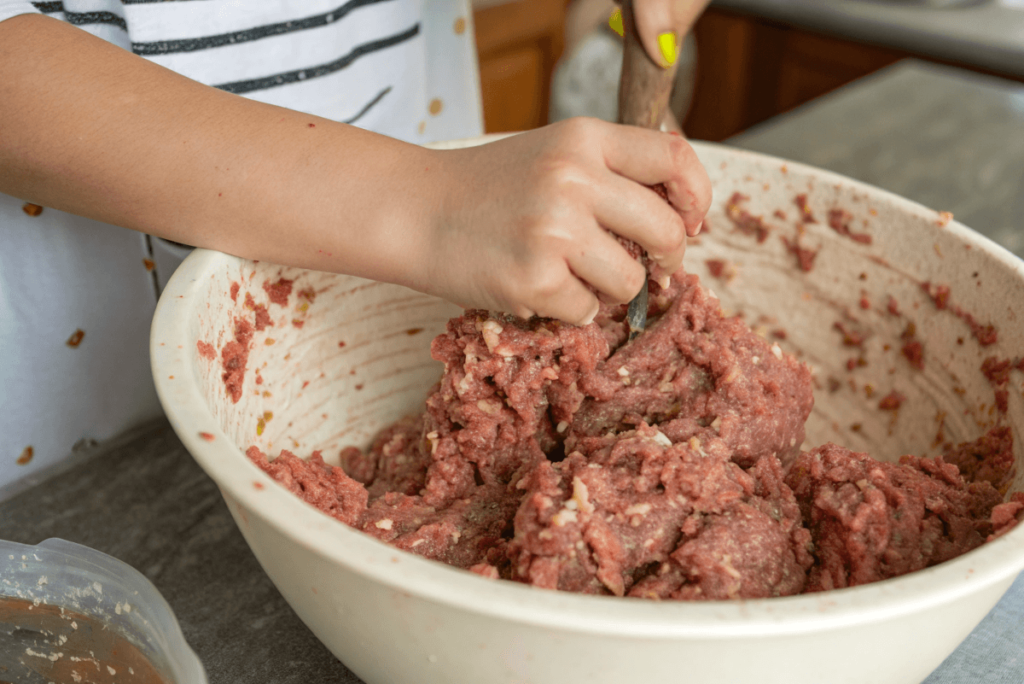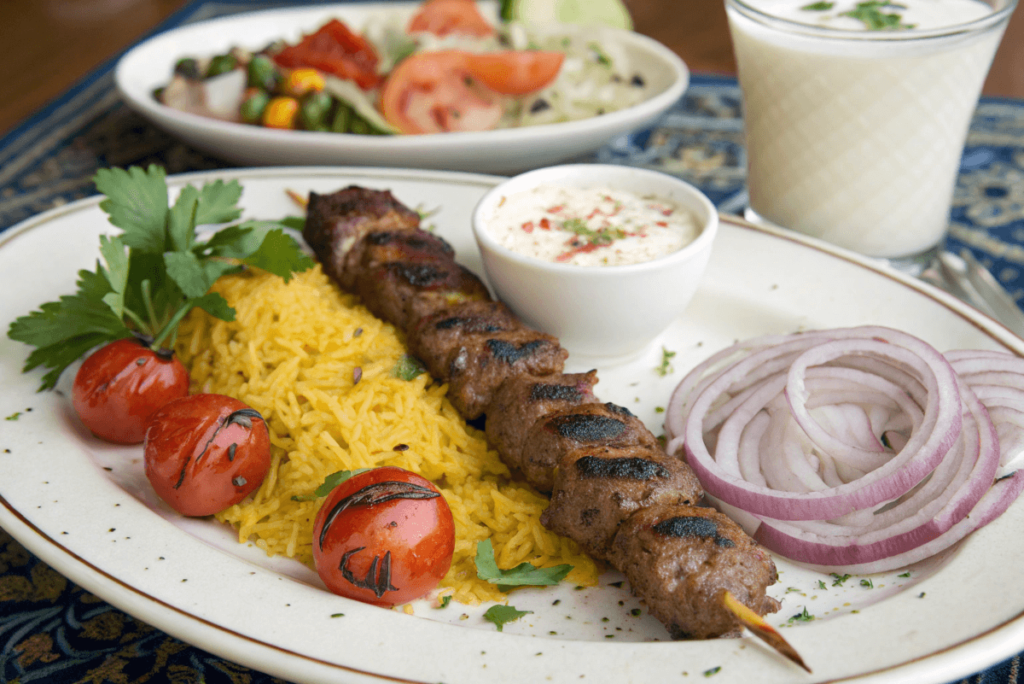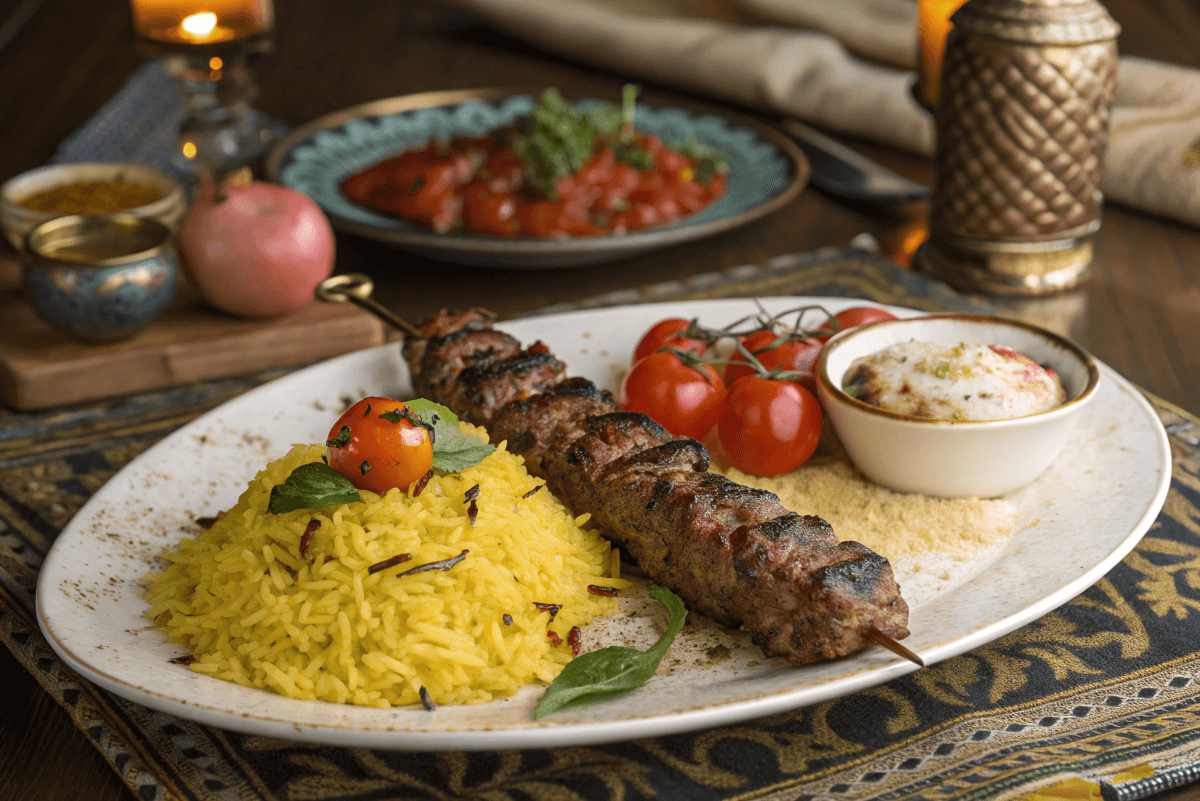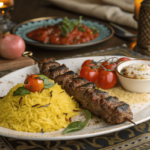Introduction
If you’re a fan of Persian cuisine, you’ve likely heard of Kabob Koobideh. This beloved Iranian dish features juicy, seasoned ground meat skewers grilled to perfection. It’s a staple in Persian restaurants worldwide and a must-try for any kebab enthusiast.
In this guide, we’ll dive deep into everything you need to know about Kabob Koobideh—from its rich history and traditional ingredients to the best grilling techniques and serving suggestions. Whether you’re a home cook looking to perfect your recipe or just curious about this mouthwatering dish, this article will cover it all.
Now, let’s start with its origins and what makes Kabob Koobideh unique!
What is Kabob Koobideh?
Origins of Kabob Koobideh
Kabob Koobideh traces its roots back to ancient Persia, where kebabs were a common way to prepare and preserve meat. The term “Koobideh” comes from the Persian word koobidan, meaning “to beat” or “to pound”—a nod to the traditional method of mincing meat by hand.
For centuries, this dish has been a symbol of Persian hospitality. Whether served at grand feasts or cozy family gatherings, it remains a cherished part of Iranian cuisine. Today, it’s a popular menu item in Persian restaurants worldwide, often paired with chelow (buttery saffron rice) and grilled tomatoes.
What Makes It Unique?
Unlike Shish Kebab, which features chunks of meat, Kabob Koobideh is made with ground meat (usually beef, lamb, or a mix of both). The secret to its juicy, tender texture lies in the meticulous preparation—mixing the meat with grated onions and spices before carefully molding it onto skewers.
Another distinguishing factor? The charcoal grilling method, which imparts a deliciously smoky aroma and a slightly crispy exterior. Plus, traditional koobideh is cooked on flat metal skewers (sikh), ensuring even cooking and preventing the meat from falling apart.
Common Variations
Though the classic beef and lamb koobideh remains the most popular, there are plenty of variations:
- Chicken Koobideh – A lighter alternative made with ground chicken and saffron
- Koobideh with Sumac – A tangy twist, dusted with ground sumac before serving
- Spicy Koobideh – Infused with chili flakes for a fiery kick
No matter the variation, the key to authentic Kabob Koobideh lies in its rich seasoning, smoky grilling, and mouthwatering aroma.
Ingredients Needed for Authentic Kabob Koobideh
Primary Ingredients
Making Kabob Koobideh starts with just a few simple yet essential ingredients. Here’s what you’ll need:
- Ground meat – Traditionally, a mix of 80% beef and 20% lamb provides the perfect balance of flavor and fat.
- Onions – Grated onions add moisture and a hint of sweetness.
- Garlic (optional) – Some recipes include minced garlic for extra aroma.
- Spices – A blend of salt, black pepper, sumac, turmeric, and saffron enhances the dish’s authentic taste.
- Breadcrumbs or flour (optional) – Helps bind the meat if it’s too wet.
Best Meat to Use
For a juicy and flavorful Kabob Koobideh, selecting the right meat is crucial:
- Lamb – Rich and traditional, but higher in fat.
- Beef – Leaner but still flavorful when mixed with lamb.
- Chicken – A lighter, healthier alternative with saffron for a golden hue.
Essential Spices and Herbs
Persian cuisine is known for its warm, aromatic flavors. Adding sumac—a tangy red spice—gives koobideh its signature taste. Some chefs also sprinkle dried mint or coriander for a slight herbal touch.
Now that we have all the ingredients ready, let’s move on to how to make Kabob Koobideh step by step!
Step-by-Step Guide to Making Kabob Koobideh

Preparing the Meat Mixture
The first step to making perfect Kabob Koobideh is properly preparing the meat:
- Grate the onions and squeeze out excess water using a cheesecloth. Too much moisture will make the kebabs fall apart.
- Mix the ground meat with spices (salt, black pepper, sumac, turmeric, and saffron) thoroughly.
- Knead the mixture for at least 10 minutes until it becomes sticky and well combined. This step is crucial for binding.
- Chill the mixture in the fridge for 1-2 hours to firm up.
Shaping and Skewering

Unlike typical skewers, Persian kebabs use wide metal skewers to help the meat cook evenly.
- Take a handful of meat mixture and shape it into a long sausage around the skewer.
- Press the meat gently but firmly so it sticks to the skewer.
- Use wet hands to smooth out any cracks and ensure even thickness.
Grilling to Perfection
The real magic of Kabob Koobideh happens over a charcoal grill. Follow these steps for the best results:
- Preheat the grill until the charcoal is hot and glowing.
- Place skewers over direct heat, flipping every minute to prevent burning.
- Grill for about 4-5 minutes per side until golden brown and slightly crispy.
Pro tip: If grilling isn’t an option, you can cook koobideh in an oven at 400°F (200°C) for about 15-20 minutes, turning once halfway.
Common Mistakes to Avoid
- Meat falling off the skewer? Add a tablespoon of flour or breadcrumbs.
- Too dry? Use higher-fat meat or add butter to the mix.
- Uneven cooking? Ensure skewers are not too thick, and cook over medium heat.
Now that your kebabs are ready, it’s time to serve them up! In the next section, we’ll explore the best ways to enjoy Kabob Koobideh with traditional and modern sides.
Traditional and Modern Serving Suggestions
Classic Persian Sides for Kabob Koobideh

No Kabob Koobideh meal is complete without the perfect side dishes. In traditional Persian cuisine, this kebab is typically served with:
- Chelow (Persian Saffron Rice) – A buttery, aromatic rice topped with saffron for vibrant color and rich flavor.
- Grilled Tomatoes – Charring tomatoes on the grill alongside koobideh adds a smoky sweetness.
- Raw Onions & Fresh Herbs – Slices of onion and sabzi khordan (a mix of fresh basil, parsley, and mint) balance the richness of the meat.
- Torshi (Pickled Vegetables) – A tangy side that enhances the kebab’s flavor.
Modern Twists and Creative Serving Ideas
If you want to experiment beyond tradition, here are some modern ways to enjoy Kabob Koobideh:
- Koobideh Wraps – Serve in lavash or pita bread with garlic yogurt sauce.
- Koobideh Bowls – Layer grilled koobideh over quinoa, brown rice, or roasted veggies for a healthy twist.
- Persian Fusion Burgers – Use koobideh meat to create Persian-style burger patties!
Best Drinks to Pair With Kabob Koobideh
To elevate your meal, try these classic Persian drinks:
- Doogh (Persian Yogurt Drink) – A refreshing, slightly salty yogurt-based drink with dried mint.
- Persian Saffron Tea – A fragrant tea that complements the rich flavors of koobideh.
- Shirazi Lemonade – A citrusy drink that balances the smoky taste of grilled meat.
Now that we’ve covered the best ways to serve Kabob Koobideh, let’s talk about its nutritional value and how it fits into different diets.
Nutritional Benefits and Dietary Considerations
Protein and Nutrient Content in Kabob Koobideh
Since Kabob Koobideh is made from ground beef and lamb, it is packed with:
- High-quality protein – Essential for muscle building and overall health.
- Iron and Zinc – Important for immune function and energy production.
- Healthy Fats – Depending on the meat-to-fat ratio, koobideh can be a good source of healthy fats.
However, the calorie count varies based on the type of meat used. Leaner beef or chicken makes it a healthier option, while fattier lamb adds more richness but also more calories.
Caloric Breakdown of Kabob Koobideh
On average, a single koobideh skewer (around 120g) contains:
- 250-300 calories
- 18-22g protein
- 20g fat (if using 80/20 ground beef)
Adding butter-infused Persian rice and grilled tomatoes will increase the total calorie count.
Keto and Low-Carb Modifications
If you’re following a low-carb or keto diet, you can still enjoy Kabob Koobideh by:
- Skipping the rice and serving it with roasted vegetables or a salad.
- Using lean meats like chicken or turkey for a lower-fat version.
- Pairing with Greek yogurt dip instead of carb-heavy sides.
For those who prefer plant-based options, check out Miral Recipes’ vegan lentil soup for a protein-packed, vegetarian-friendly dish.
Kabob Koobideh Around the World
Persian Restaurants and Global Popularity
Kabob Koobideh may have originated in Persian cuisine, but it has found a home in restaurants worldwide. From Los Angeles to London, Persian eateries serve this beloved dish, often paired with Chelow (buttery saffron rice) and grilled tomatoes.
In countries with large Iranian communities, such as the U.S., Canada, and Australia, authentic koobideh can be found in Persian restaurants. Many of these places follow traditional charcoal-grilling methods, ensuring the kebabs retain their signature smoky flavor.
Regional Adaptations
As Kabob Koobideh traveled the world, different cultures put their own spin on it:
- Turkey – Similar to Adana Kebab, but often spicier with red pepper flakes.
- Pakistan & India – Sometimes infused with garam masala and served with naan.
- Middle East – Found in Lebanese and Iraqi cuisine, often with tahini or garlic sauce.
Despite these variations, the essence of Kabob Koobideh remains the same—juicy, well-seasoned meat cooked over an open flame.
Frequently Asked Questions
1. Why does my Kabob Koobideh fall off the skewer?
This is one of the most common problems. The key is to knead the meat well until it becomes sticky. Also, removing excess water from the grated onions and chilling the mixture before grilling helps maintain its shape.
2. Can I make Kabob Koobideh without a grill?
Yes! While a charcoal grill provides the best flavor, you can also cook koobideh:
In an oven at 400°F (200°C) for 15-20 minutes.
On a stovetop grill pan, flipping every few minutes for even cooking.
3. What’s the difference between Kabob Koobideh and Shish Kebab?
Shish Kebab uses chunks of meat on skewers, while Kabob Koobideh is made from ground meat, shaped around flat metal skewers for a softer texture.
4. How do I store and reheat leftovers?
To keep Kabob Koobideh fresh:
Refrigerate in an airtight container for up to 3 days.
Freeze for longer storage, separating layers with parchment paper.
Reheat in an oven at 350°F (175°C) until warmed through.
Tips for Perfecting Kabob Koobideh at Home
Choose the Right Meat for the Best Texture
The secret to juicy and flavorful Kabob Koobideh lies in selecting the perfect meat blend. Using 80% lean ground beef and 20% lamb gives the kebabs a tender and moist texture. If the meat is too lean, the kebabs may turn out dry.
For the best results:
- Use freshly ground meat instead of pre-packaged minced meat.
- If you prefer leaner meat, add a small amount of butter or beef fat for extra moisture.
- Grind the meat twice to achieve a smooth, sticky consistency.
Knead and Chill the Meat Mixture
Proper mixing is crucial for binding the ingredients together. Knead the meat mixture for at least 10 minutes until it becomes sticky—this ensures the kebabs hold their shape on the skewers.
After mixing, let the meat rest in the fridge for 1-2 hours. This step helps the flavors meld and makes shaping the skewers easier.
Master the Skewering Technique
Shaping the meat correctly ensures even cooking and prevents it from falling apart. Follow these steps:
- Wet your hands with cold water before handling the meat.
- Take a handful of meat and shape it evenly around a flat metal skewer.
- Press lightly along the skewer, creating small ridges with your fingers. These ridges help cook the koobideh evenly.
Grill at the Right Temperature
- Use charcoal for the best smoky flavor.
- Flip the skewers frequently (every 30-60 seconds) to prevent burning.
- Cook over medium-high heat for 8-10 minutes until golden brown.
By following these tips, you’ll achieve restaurant-quality Kabob Koobideh right in your own kitchen!
Exploring Other Persian Kebabs
Koobideh vs. Other Persian Kebabs
While Kabob Koobideh is a Persian favorite, Iranian cuisine features several other delicious kebabs. Here’s how koobideh compares:
| Kebab Type | Meat Used | Key Features |
|---|---|---|
| Kabob Koobideh | Ground beef/lamb | Juicy, seasoned meat, molded onto skewers |
| Kabob Barg | Filet mignon or lamb | Thinly sliced, marinated in saffron and butter |
| Joojeh Kabob | Chicken | Marinated in saffron, yogurt, and lemon juice |
| Chenjeh Kabob | Lamb or beef chunks | Rich, meaty texture with minimal seasoning |
| Shishlik Kabob | Bone-in lamb chops | Grilled with simple seasoning, very tender |
Which One Should You Try?
- If you love soft, melt-in-your-mouth kebabs, go for Kabob Koobideh.
- Prefer tender, marinated steak? Try Kabob Barg.
- Looking for a chicken option? Joojeh Kabob is a must.
- Want something hearty? Chenjeh Kabob is perfect for meat lovers.
Pairing Different Kebabs for a Feast
In Persian cuisine, different kebabs are often served together for a grand meal. A popular combination is:
- Kabob Koobideh + Joojeh Kabob – The perfect mix of beef and chicken.
- Kabob Barg + Koobideh – A balance of tender steak and juicy ground meat.
- Chenjeh + Koobideh – A meaty feast with two distinct textures.
Exploring different Persian kebabs adds variety to your meals and lets you experience the rich flavors of Persian grilling traditions!
Conclusion
From its ancient Persian roots to its global popularity, Kabob Koobideh remains one of the most beloved kebabs in the world. Whether you’re enjoying it at a traditional Persian restaurant or grilling it at home, the key to perfect koobideh lies in the right meat selection, proper seasoning, and expert grilling techniques.
We’ve covered everything from its history and ingredients to step-by-step cooking tips and perfect side dishes. You also learned how it compares to other Persian kebabs and how to make the best koobideh right in your kitchen. With the right approach, you can create authentic, juicy Kabob Koobideh that rivals any restaurant’s version.
Now, it’s time to fire up the grill and bring the rich flavors of Persian cuisine to your table!
PrintDelicious : The Ultimate Guide to Juicy Persian Kebabs
A traditional Persian dish made from seasoned ground meat, shaped onto skewers, and grilled over an open flame. This kebab is known for its juicy texture and smoky flavor.
- Prep Time: 15 minutes.
- Cook Time: 10 minutes.
- Total Time: 25 minutes.
- Yield: Serves 4–6 people 1x
- Category: Dinner
- Method: Grilling over charcoal for an authentic smoky flavor. Alternative: Oven-baked at 400°F (200°C) for 15-20 minutes, turning once.
- Cuisine: Persian, Middle Eastern.
- Diet: Gluten Free
Ingredients
- 1 lb ground beef (80% lean, 20% fat)
- ½ lb ground lamb (optional for extra flavor)
- 1 large onion, grated and excess water removed
- 1 teaspoon salt
- 1 teaspoon black pepper
- 1 teaspoon sumac
- ½ teaspoon turmeric
- 1 teaspoon saffron, dissolved in warm water
- 1 clove garlic, minced (optional)
- 1 tablespoon butter (for basting)
Instructions
- In a large bowl, mix ground beef, lamb, and grated onions until well combined.
- Add salt, pepper, sumac, turmeric, and saffron water, then knead the mixture for about 10 minutes until sticky.
- Cover and refrigerate for at least 1 hour to let the flavors develop.
- Wet your hands, take a handful of the meat mixture, and mold it around flat metal skewers, pressing ridges into the surface.
- Preheat a charcoal grill or stovetop grill pan.
- Grill the skewers over medium-high heat, turning every minute for 8-10 minutes, until browned and slightly charred.
- Baste with melted butter before serving for extra juiciness.
- Serve with saffron rice, grilled tomatoes, fresh herbs, and doogh (Persian yogurt drink).
Nutrition
- Calories: 300 kcal
- Sodium: 350mg
- Fat: 22g
- Carbohydrates: 3g
- Fiber: 0.5g
- Protein: 20g
Keywords: Kabob Koobideh, Persian kebab, Iranian grilled meat, koobideh recipe, best koobideh, Persian BBQ, Persian cuisine, ground beef kebab.


